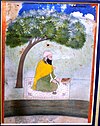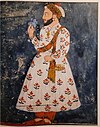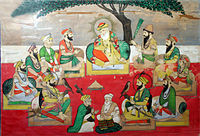Sikh gurus
| Part of a series on |
| Sikhism |
|---|
 |
The Sikh gurus (Punjabi: ਸਿੱਖ ਗੁਰੂ; Hindi: सिख गुरु) are the spiritual masters of Sikhism, who established the religion over the course of about two and a half centuries, beginning in 1469.[2] The year 1469 marks the birth of Guru Nanak, the founder of Sikhism. He was succeeded by nine other human gurus until, in 1708, the Guruship was finally passed on by the tenth guru to the holy Sikh scripture, Guru Granth Sahib, which is now considered the living Guru by the followers of the Sikh faith.[3]
Etymology and definition
Guru (
According to Sikh beliefs, all the Gurus contained the same light or soul and their physical body was a vessel for containing the same essence. When one Guru passed, the successor inherited this light and that is why the Gurus are also referred to as mahalla (house).[7]
The gurus
| No. | Name | Portrait | Birth date | Guruship | Birthplace | Clan | Father | Mother | Date of death | Reason | Place of death |
|---|---|---|---|---|---|---|---|---|---|---|---|
| 1 | Guru Nanak | 
|
14 April 1469 [note 1] | Since birth | Nankana Sahib, Punjab, Delhi Sultanate | Bedi Khatri | Kalyan Das Bedi | Mata Tripta | 22 September 1539 (aged 70) | Natural causes | Kartarpur, Punjab, Mughal Empire |
| 2 | Guru Angad | 
|
31 March 1504 | 7 September 1539 | Muktsar, Punjab, Mughal Empire
|
Trehan Khatri | Baba Pheru Mal | Mata Ramo | 29 March 1552 (aged 47) | Natural causes | Khadur Sahib, Punjab, Mughal Empire |
| 3 | Guru Amar Das | 
|
5 May 1479 | 26 April 1552 | Amritsar, Punjab, Mughal Empire | Bhalla Khatri | Tej Bhan Bhalla | Mata Lachmi | 1 September 1574 (aged 95) | Natural causes | Lahore Subah, Mughal Empire
|
| 4 | Guru Ram Das | 
|
24 September 1534 | 1 September 1574 | Lahore, Punjab, Mughal Empire | Sodhi Khatri | Baba Har Das | Mata Daya | 1 September 1581 (aged 46) | Natural causes | Lahore Subah, Mughal Empire
|
| 5 | Guru Arjan | 
|
15 April 1563 | 1 September 1581 | Goindval, Punjab, Mughal Empire | Sodhi Khatri | Guru Ram Das | Mata Bhani | 30 May 1606 (aged 43) | Execution by Mughal Emperor Jahangir
|
Lahore Subah, Mughal Empire
|
| 6 | Guru Hargobind | 
|
19 June 1595 | 25 May 1606 | Lahore Subah, Mughal Empire
|
Sodhi Khatri | Guru Arjan | Mata Ganga | 28 February 1644 (aged 48) | Natural causes | Lahore Subah, Mughal Empire
|
| 7 | Guru Har Rai | 
|
16 January 1630 | 3 March 1644 | Lahore Subah, Mughal Empire
|
Sodhi Khatri | Baba Gurditta | Mata Nihal Kaur | 6 October 1661 (aged 31) | Natural causes | Delhi Subah, Mughal Empire
|
| 8 | Guru Har Krishan | 
|
7 July 1656 | 7 October 1661 | Lahore Subah, Mughal Empire
|
Sodhi Khatri | Guru Har Rai | Mata Krishan Kaur | 30 March 1664 (aged 7) | Smallpox | Delhi Subah, Mughal Empire
|
| 9 | Guru Tegh Bahadur | 
|
1 April 1621 | 20 March 1664 | Lahore Subah, Mughal Empire
|
Sodhi Khatri | Guru Hargobind | Mata Nanaki | 11 November 1675 (aged 54) | Execution by Mughal Emperor Aurangzeb
|
Delhi Subah, Mughal Empire
|
| 10 | Guru Gobind Singh | 
|
14 February 1666 | 11 November 1675 | Bihar Subah, Mughal Empire
|
Sodhi Khatri | Guru Tegh Bahadur | Mata Gujri | 7 October 1708 (aged 41) | Natural Causes] | Bidar Subah, Mughal Empire
|
| 11 | Guru Granth Sahib | 
|
29 August 1604 (date of completion of compilation of the first draft [Adi Granth]) |
20 October 1708 | Lahore Subah, Mughal Empire (place of compilation) |
The central holy scripture of Sikhism, regarded as the final, sovereign and eternal Guru.
| |||||
Timeline

Pedigrees

See also
Notes
- Katak Puranmashi(October–November)
- ^ Listed names and relations might vary from source to source since different aspects of Sikh history have been written by many different individuals over the course of past six centuries
References
- ISBN 9004095543.
- ISBN 978-9-38060-734-4.
- ISBN 978-8174360373.
- ISBN 978-3638749251, p. 2–3.
- ^ Singh, Veer (1964). Sri Guru Granth Kosh. p. 122.
- ISBN 978-0-87196-129-7.
- OCLC 47024480.
The author of the Dabistan refers to the belief of the Sikhs in the unity of Guruship. The spirit of Guru Nanak entered the bodies of his successors - Guru Angad, Guru Amar Das, Guru Ram Das and Guru Arjan. That was why each Guru was referred to as mahal: Guru Nanak as the first mahal, Guru Angad as the second mahal, and in this way Guru Arjan as the fifth mahal. A Sikh who does not regard Guru Arjan as Baba Nanak is not a true Sikh. The firm belief of the Sikhs is that all the Gurus are Nanak. Indeed, Bhai Gurdas underscores the unity of Guruship from Guru Nanak to Guru Hargobind in one of his Vaars. This is reiterated in another Vaar in which the metaphors of light and water are used to emphasize that they all are the same.The idea of the unity of Guruship emphasized by Bhai Gurdas legitimized the succession of Guru Hargobind to face the rival claim of Prithi Chand and his descendants.



